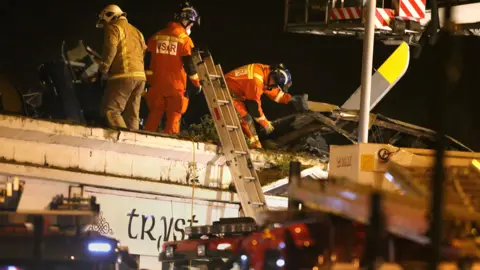Clutha helicopter crash inquiry: The key questions
 PA Media
PA MediaThe findings of a fatal accident inquiry into the Clutha helicopter crash have been published.
Sheriff Principal Craig Turnbull's 173-page report, which runs to more than 45,000 words, followed 32 days of evidence.
He found that a police aircraft crashed onto the Glasgow pub on 29 November 2013 because its pilot, Captain David Traill, ignored a series of low fuel warnings. His report looked at a number of key questions.
Why did the helicopter crash?
Sheriff Turnbull concluded the primary cause of the accident was "fuel starvation", which caused the Eurocopter EC135's twin engines to malfunction 32 seconds apart.
The sheriff said this was triggered by the fuel transfer pumps being turned off by Capt Traill.
He wrote: "There was no usable fuel in either supply tank cell when the engines flamed out."
Crucially, investigators later found 73kg in the main tank, enough to have enabled it to land safely if fuel had been able to flow to the engines.
Why were the fuel pumps turned off?
The inquiry heard there were circumstances when a pilot would turn off the fuel transfer pumps during a flight, for example if the tilting of the aircraft caused them to run dry.
Sheriff Turnbull said he was satisfied that such a scenario occurred during the final flight, which would have prompted Capt Traill to take such action.
But he added: "Regrettably, when switching off the second fuel transfer pump, Captain Traill appears to have overlooked the fact that he had previously switched off the forward fuel transfer pump approximately 11 minutes earlier."
The sheriff concluded: "The evidence before the inquiry, regrettably, cannot explain why Captain Traill acted as he did.
"It is, however, clear beyond peradventure that Captain Traill's failure to follow the procedure set down in the Pilot's Checklist caused the accident."
This stipulated he must land within 10 minutes of a warning. The sheriff also ruled it was "vanishingly unlikely" that the pilot believed he had switched the fuel transfer pumps back on.
Were the warnings accurate?
In its 2015 report into the disaster, the Air Accidents Investigation Branch (AAIB) was unable to determine precisely when Captain Trail - who had almost 5,600 hours flying experience in military and civilian helicopters - received the first of five low fuel warnings.
Sheriff Turnbull concluded that it occurred between 21:59 and 22:04 on 29 November 2013 as the aircraft approached Bothwell, South Lanarkshire.
The Sheriff said he was satisfied the helicopter thermistors, a sensor which activates the fuel warning system, were working correctly and that Capt Traill was aware of the warnings during the fateful flight.
He highlighted the conclusion of one expert who suggested that the only reason Capt Traill did not land within 10 minutes of receiving the warning was that "he considered it safe to continue the flight".
In the 32 seconds between the engines flaming out, Capt Traill failed to identify that both fuel transfer pumps had been turned off.
Autorotation - a condition of descending flight where the rotor blades are driven solely by aerodynamic forces - was not possible.
Sheriff Turnbull said: "Captain Traill had no realistic chance of landing the helicopter safely."
Was there a problem with the warnings?
The sheriff found no evidence whatsoever that Capt Traill deliberately caused G-SPAO to crash and recorded that he made a "valiant attempt" to land after both engines had flamed out.
He concluded it was more likely than not that the quantities of fuel displayed on the fuel quantity indication contradicted the low fuel warnings, in a manner that persuaded Capt Traill it was safe to continue flying.
But he said the contradictory fuel display was only of relevance until the illumination of the first low fuel warning.
At that point, Capt Traill should have started making preparations to land.
The sheriff described the pilot's failure to follow the procedures in the Pilot's Checklist as "inexplicable".
Were there previous problems with the helicopter?
Over a period of 20 years the EC135 model had accumulated more than three million flying hours without any reported instance of fuel starvation.
Sheriff Turnbull said: "The particular circumstances of this accident appear to be unique.
"Had Captain Traill performed the actions set out in the Pilot's Checklist, the accident would not have happened."
He also found no evidence the helicopter's Caution Advisory Display (CAD) failed prior to the accident.
Could the crash have been prevented?
The sheriff said that if Capt Traill had received a warning that both fuel transfer pumps were switched off, and had that warning been accompanied by an audible sound there is "a lively possibility" that he would have switched on the forward fuel transfer pump.
Had this happened, the accident "might realistically have been avoided".
In his findings, Sheriff Turnbull said there were two "reasonable precautions" which could have prevented the crash:
- For Capt Traill to have followed the Pilot's Checklist procedures for dealing with the low fuel warnings
- For Airbus to have installed a warning system which activated when both fuel transfer pumps had been switched off.
The sheriff ruled it was "not appropriate" to make any recommendations in his report, and highlighted the fact the AAIB made safety recommendations in its 2015 report.
And he concluded that the circumstances were "so unusual that it is improbable they will be repeated".